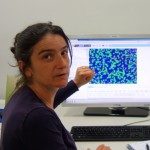Link to Pubmed [PMID] – 15923373
RNA 2005 Jun;11(6):864-72
RNA interference in mammalian cells is actively used to conduct genetic screens, to identify and to validate targets, and to elucidate regulators and modifiers of cellular pathways. To ensure the specificity and efficacy of the active 21mer siRNA molecules, it is pertinent to develop a strategy for their rational design. Here we show that most functional siRNAs have characteristic sequence features. We tested 601 siRNAs targeting one exogenous and three endogenous genes. The efficacy of the siRNAs was determined at the protein level. Using a decision tree algorithm in combination with information analysis, our analyses revealed four sets of rules with a mean knockdown efficacy ranging from 60% to 73%. (To distinguish between percentages used to describe the quality of an siRNA and the percentages used to describe parts of data sets we underlined the former throughout this paper.) The best rule comprises an A/U at positions 10 and 19, a G/C at position 1, and more than three A/Us between positions 13 and 19, in the sense strand of the siRNA sequence. Using these rules, there is a 99.9% chance of designing an effective siRNA in a set of three with more than 50% knockdown efficiency in a biological readout.




